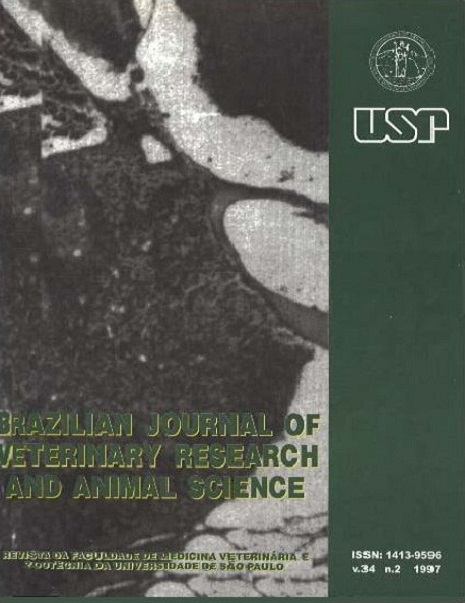Degradabilidade “in situ” da fibra do bagaço de cana-deaçúcar tratado com soluções alcalinas e da proteína do farelo de algodão, em bovinos fistulados
DOI:
https://doi.org/10.11606/issn.2318-3659.v34i2p73-77Palavras-chave:
Digestibilidade, Soluções, Alcalino, Farelo de algodão, Bagaço de cana-de-açúcar, BovinosResumo
Foram utilizados quatro bovinos, mestiços europeu/zebu com peso médio de 150 kg, dotados de cânulas ruminais, para estimar as taxas de degradabilidade in situ da matéria seca e da fibra em detergente neutro, do bagaço de cana-de-açúcar, bem como da matéria seca e da proteína bruta do farelo de algodão. Foram comparados quatro tratamentos: A- Bagaço de cana-de-açúcar tratado por imersão em água (pH = 6,5) e mistura de concentrados contendo tampões; B- Bagaço de cana-de-açúcar tratado com água e mistura de concentrados (controle); C- Bagaço de cana-de-açúcar tratado com solução a 30% de cinza de madeira (pH = 11,0) e mistura de concentrados; D- Bagaço de cana-de-açúcar tratado com solução a 2% de hidróxido de sódio (pH = 11,5) e mistura de concentrados. O delineamento foi o quadrado latino (4 x 4) e os seguintes resultados foram obtidos: a degradabilidade da matéria seca do bagaço de cana-de-açúcar foi maior para o tratamento D, bem como para a fibra em detergente neutro, porém, neste caso, nos tempos de incubação 72 h e 96 h. O farelo de algodão apresentou degradabilidades da matéria seca e da proteína bruta iguais em todos os tratamentos. O tratamento D foi eficiente para aumentar a degradabilidade ruminal do bagaço da cana-de-açúcar.Downloads
Downloads
Publicado
1997-04-01
Edição
Seção
NUTRIÇÃO ANIMAL E DOENÇAS NUTRICIONAIS
Licença
O conteúdo do periódico está licenciado sob uma Licença Creative Commons BY-NC-SA (resumo da licença: https://creativecommons.org/licenses/by-nc-sa/4.0 | texto completo da licença: https://creativecommons.org/licenses/by-nc-sa/4.0/legalcode). Esta licença permite que outros remixem, adaptem e criem a partir do seu trabalho para fins não comerciais, desde que atribuam ao autor o devido crédito e que licenciem as novas criações sob termos idênticos.
Como Citar
1.
Sonksen S, Lucci C de S, Melotti L. Degradabilidade “in situ” da fibra do bagaço de cana-deaçúcar tratado com soluções alcalinas e da proteína do farelo de algodão, em bovinos fistulados. Braz. J. Vet. Res. Anim. Sci. [Internet]. 1º de abril de 1997 [citado 5º de abril de 2025];34(2):73-7. Disponível em: https://revistas.usp.br/bjvras/article/view/50247





